Back in
May (2008), I took Andy for a walk at the Joseph
D. Grant County Park...
For the most part, the hiking trial
was on dirt-road. There however was a small portion of the
trial that lead us through a meadow-like grassy area. Immediately
after we passed this grassy area and were back on dirt road,
I noticed a couple of dark "things" crawling up on Andy's
legs.
I asked to wait so I could examine him
a little closer. What I saw was unbelievable, there were 8
ticks crawling up his legs. None of them was attached yet
so they were easy to remove. Even worse, there were also 2
ticks crawling up my socks...
In most areas of the United States, ticks are active from
about April to November, but with California's temperate climate,
adult ticks are also abundant between late October and March.
Ticks are not only an irritant. Tick bites can transmit diseases
that cause serious illness in dogs and even humans. Without
a doubt, some of the more dangerous diseases transmitted by
ticks are Ehrlichiosis, Babesiosis, RMSF (Rocky Mountain Spotted
Fever) and Lyme Disease. All of them may be extremely disabilitating
or even fatal to your dog unless diagnosed in time and treated
aggressively!
States in the Northeastern, North central, and Pacific coast
regions of the United States have the highest concentrations
of ticks that carry these potentially deadly diseases. The
ticks most often responsible for carrying Lyme disease are
the Deer tick in the Northeast and Upper Midwest, the Black-legged
tick in the Midwest and Southeast, and the Western black-legged
tick in coastal areas of Washington, Oregon, and California.
RMSF is transmitted by both the American dog tick and the
Wood tick (the name RMSF is somewhat misleading because the
disease has been reported in almost every American state).
Deer Ticks:
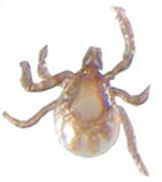 |
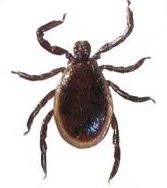 |
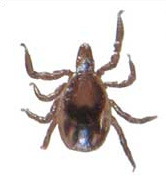 |
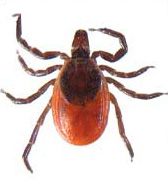 |
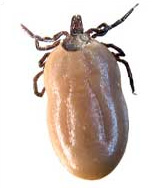 |
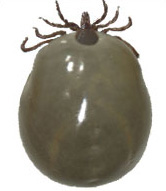 |
Larvae |
Nymph |
Adult Male |
Adult Female |
Partially Engorged Female |
Fully
Engorged
Female |
American Dog Ticks:
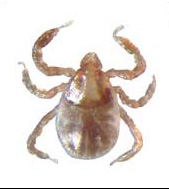 |
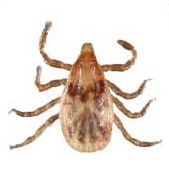 |
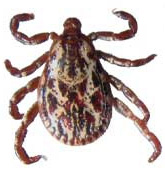 |
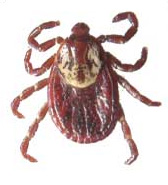 |
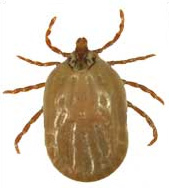 |
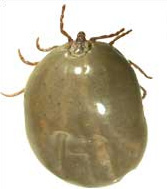 |
Larvae |
Nymph |
Adult Male |
Adult Female |
Partially Engorged Female |
Fully
Engorged
Female |
NOTE: The ticks in these images above are not show in their
actual size - except for engorged ticks. For example, the
larval deer ticks are less than 1 millimeter in diameter.
Click on the images above to visit the tick information website
provided by the University of Rhode Island. This is a great
resource with a flash applet that depicts each tick in its
actual size and in a magnified view.
Here are these ticks in their real sizes next to a dime:
|
|
|
|
|
Larval Deer Tick |
Nymphal Deer Tick |
Adult Male Deer Tick |
Adult Female Deer Tick |
Adult Female American Dog Tick |
Ticks attach themselves by embedding their claw-like mouth
parts into your dogs skin so they can feed on it's blood.
It is said that they are most often found around a dog's head
and neck, but most ticks that I found attached to Andy were
on his legs (he is a pretty tall guy). If an attached tick
is not found and removed immediately, it becomes larger (engorged)
as it feeds.
Usually, an infected tick must be attached to its host from
5 to 20 hours for transmission of a disease to occur. For
this reason, the sooner you manage to get a tick off your
dog the less likely it is that a disease is being transmitted.
However, it is important to understand that a tick-borne disease
may also be transmitted through contact with infected tick
hemolymph or excrement (especially when engorged ticks are
crushed).
HOW TO REMOVE TICKS
You should always inspect your dog from nose to tail to check
for ticks after your dog has been in high grasses or wooded
areas. If you find any, remove them as soon as possible!
What you need: Disposable latex gloves, a small jar with
a lid, a tick removal tool such as fine point tweezers or
the "Ticked Off" removal spoon (which is working incredibly
well from me), some cotton balls and hydrogen peroxide.
Do not attempt to pull the tick with your bare fingers! The
last thing you want is to end up with tick saliva under your
fingernails.
Fill the jar with a small amount of hydrogen peroxide. Wear
the protective gloves and with the removal tool, carefully
grasp the tick as close to the dog's skin as possible and
gently pull with steady pressure in one straight move until
it comes off. Do your best not to squeeze the tick's body
while you are pulling because you want to avoid squishing
potentially contaminated tick fluids onto your dog's skin.
Put the tick into the jar and close the lid. The hydrogen
peroxide will kill the tick (while flushing it down the toilet
does not!). Use the cotton balls and soak the area where the
tick was attached with hydrogen peroxide to clean it.
| |
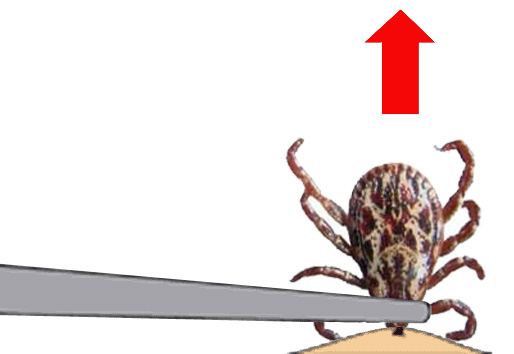 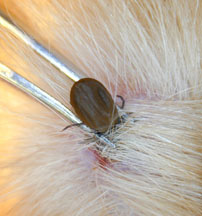 |
In the past, I was sometimes worried that the tick's head
breaks off and remains stuck in the dog's skin. This however
is rarely the case. The bump that may appear on your dog's
skin once you remove the tick is most likely an inflammation
(similar to what you see after a mosquito bite). Check this
area once a day and if it gets infected or considerably larger,
have your veterinarian take a look.
If your dog has more that just a few ticks or it is impossible
for you to pull them out, another way to deal with this is
to immediately put a Preventic tick collar on your dog which
contains the active ingredient amitraz. This collar is made
by Virbac and it not only kills ticks, it causes them to completely
detach within 48 hours. They are available in most major pet
supply stores.
TICK PREVENTION
Once you have removed all ticks from your dog, it is a good
idea to make sure others won't return in their place. I am
using Frontline Plus by Merial as a topical treatment on Andy.
Frontline Plus kills all stages of 4 major ticks (including
the American dog tick and the Lyme disease contracting deer
tick). I still sometimes find a dead tick on Andy, but they
are neither attached to his skin nor engorged which tells
me that the treatment is working well. Frontline Plus also
protects from fleas. The topical solution needs to be re-applied
every 30 days.
| |
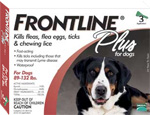 |
It is also strongly recommended to inspect and potentially
treat infested dog house, kennels and bedding. If you have
a backyard, removing piles of leaves in shaded areas around
shrubs, under decks, and along fences and walls. Keep lawns
mowed and edges trimmed. Clean up around bird feeders so mice,
chipmunks, and squirrels are not drawn to the area...rodents
attract ticks and fleas. If you suspect ticks in your yard,
you can treat it with the Virbac yard spray concentrate that
kills fleas and ticks while not harming grass or foliage.
External link:
Scary:
Researchers find no safe place to sit in California tick-infested
forest
|